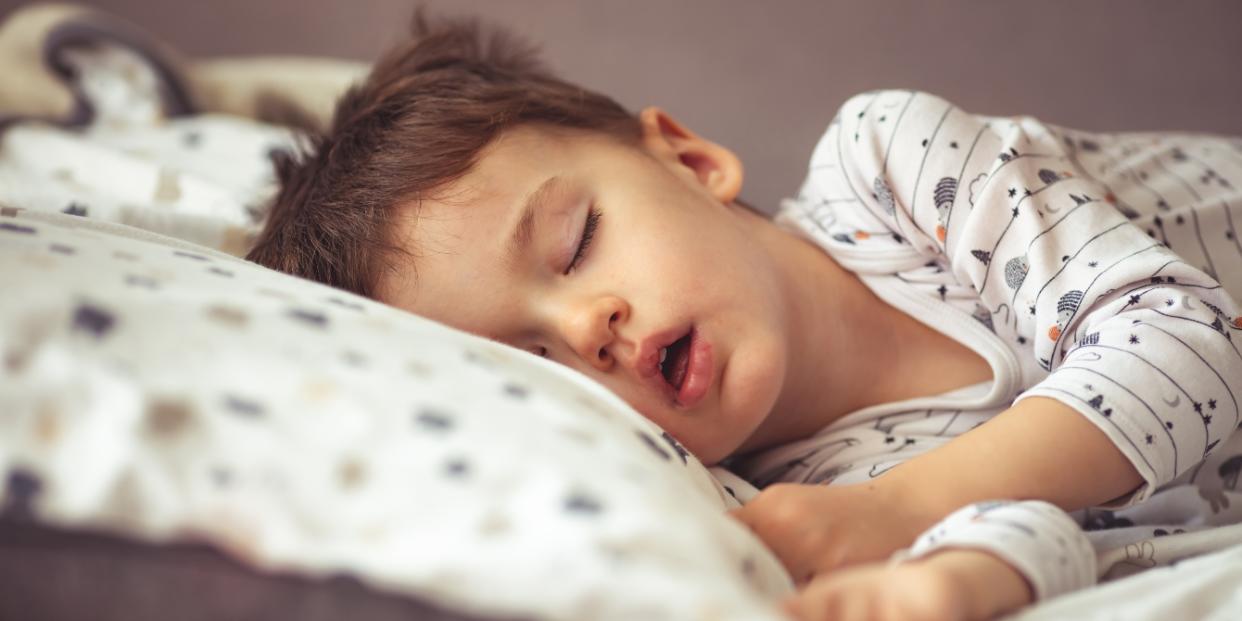Does my child have sleep apnea?

Sleep apnea is a common but unpleasant condition where your breathing repeatedly stops and starts while you’re asleep. The most common form of the condition is known as obstructive sleep apnea, or OSA. Obstructive sleep apnea occurs when the muscles in the back of the throat block airflow into the lungs because they are too relaxed. Some estimates find that as many as a quarter of adults have obstructive sleep apnea. But children can be affected, too. The condition may look different in kids, but if your child has pediatric sleep apnea, it can be difficult and disruptive to live with. Mary Anne Tablizo, MD, a board certified physician in sleep medicine and pediatric pulmonology and a clinical associate professor at Stanford University, spoke with Motherly and shared what parents should know about obstructive sleep apnea (OSA) in children.
Signs of sleep apnea in kids
With adults, one of the most prominent signs of obstructive sleep apnea is that despite getting a full night’s rest, they’re exhausted the next day. With kids, says Dr. Tablizo, you’re less likely to see this. “Children will typically manifest OSA with behavioral problems, such as hyperactivity, impulsivity, aggression and difficulty regulating mood with frequent irritability due to fragmented sleep,” she says. (If you’ve ever seen an overtired kid, you probably know they’re not exactly acting tired most of the time.) “Daytime sleepiness also may manifest as age-inappropriate sleepiness, like falling asleep during school, during short car rides and napping after school,” she says.
For other signs, you’ll want to watch your kid while they’re snoozing: keeping an ear out for loud snoring or heavy breathing during sleep, difficulty breathing during sleep, or observable moments where they seem to stop breathing momentarily (aka apneas). If you’re noticing any of these symptoms, you’ll also want to pay attention to whether they complain of headaches in the morning, if they’re having bedwetting or night sweating episodes, and if they breathe through their mouth during the day, says Dr. Tablizo. If your kid has a collection of these symptoms, it’s time for a visit to their doctor.
Diagnosis of sleep apnea in kids
Your child’s doctor will perform a physical exam, and they may give you a questionnaire to fill out about your kid’s sleep habits. During the exam, they’re typically looking for enlarged tonsils, as enlarged tonsils and adenoids are the most common cause of obstructive sleep apnea in children, says Dr. Tablizo. They’ll also look for anything that might be affecting your child’s breathing, whether that’s things like a small jaw, enlarged tongue, mouth breathing, or nasal speech. “[Kids with OSA] can also present with chronic nasal congestion, which may be from allergies,” she says.
Your doctor will also evaluate your child’s growth. “Poor growth can be a sign of chronic severe OSA, particularly in infants and young children, but paradoxically, obesity is an important risk factor,” explains Dr. Tablizo, because of how obesity contributes to airway narrowing.
Other risk factors for sleep-disordered breathing include having family members who have sleep apnea, second-hand smoke exposure, asthma, allergic rhinitis.
If your doc suspects sleep apnea, they’ll most likely order a sleep study performed. “Many children who snore do not have OSA, and although rare, the absence of snoring is also insufficient to exclude OSA,” says Dr. Tablizo. “Hence, a sleep study is needed to establish the diagnosis.”
Treatment of sleep apnea in kids
First, know that a diagnosis of sleep apnea is relatively rare. OSA occurs in 1% to 5% of children, says Dr. Tablizo. “It can occur at any age and may be most common in those between 2 and 6 years of age, though because of the rise in obesity, it is increasingly seen in the adolescent population as well.”
If your child is diagnosed, the first step is usually removing the tonsils and adenoids. This can be really helpful for children dealing with OSA, but if for some reason this isn’t the best treatment (for example, if their tonsils/adenoids aren’t enlarged), there are other options. You may conjure up an image of an adult with sleep apnea using a continuous positive airway pressure (CPAP) breathing machine, and these are an option. “It can be difficult for children to use the CPAP device every night, but effective if the child is able to tolerate it,” says Dr. Tablizo.
Some kids also do well with palate expanders or myofunctional therapy (training exercises for the muscles in the tongue, face and mouth). For milder cases, treating allergies and changing sleep positions can help, too.
While it might sound scary, there’s a lot you can do as a parent to help your child with sleep apnea, especially if you act fast. “Untreated OSA is associated with learning and behavioral problems, cardiovascular complications, and impaired growth,” says Dr. Tablizo. “Early diagnosis and treatment of OSA may decrease possible complications.”


